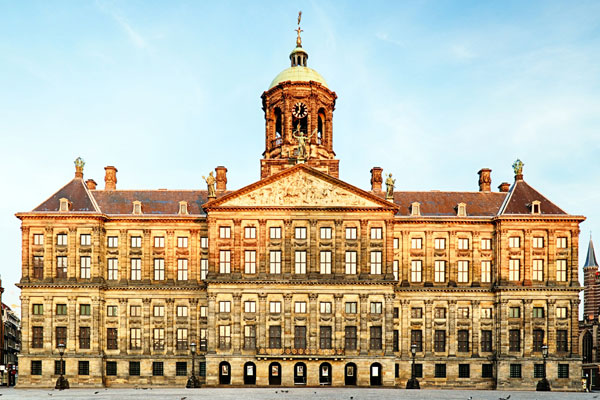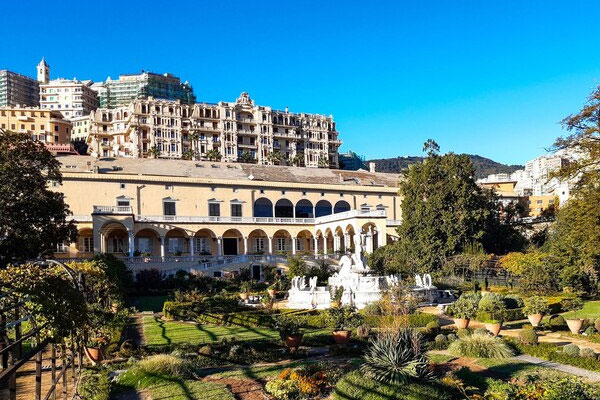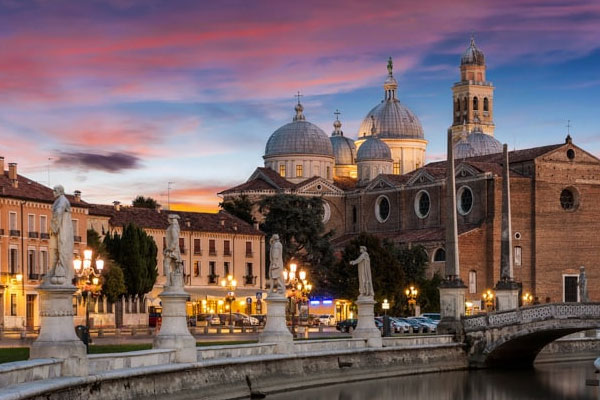Travel
Royal Palace in Amsterdam

Royal Palace in Amsterdam
Explore the Majestic Royal Palace in Amsterdam :
Amsterdam, the captivating capital of the Netherlands, stands as a testament to a rich architectural heritage that has enamored travelers worldwide. Among the city’s treasures, the Royal Palace in Amsterdam, affectionately known as the “pearl of the city,” stands out as a historical marvel.
In this comprehensive guide, we delve into the reasons to visit this iconic palace, unravel its fascinating history, and provide practical details for an enriching exploration.
Why You Should Visit the Royal Palace in Amsterdam
The Royal Palace in Amsterdam is not just a structure; it is a repository of centuries-old royal receptions, dating back to the 17th century. Once considered the largest administrative building in Europe, it recently laid claim to the title of the eighth wonder of the world.
Stepping into this regal abode, visitors are treated to a visual feast of paintings by esteemed artists, including Rembrandt and Govert Flinck. During holidays, Dutch monarchs extend greetings to their subjects from the palace balcony, creating a memorable spectacle. Tourists consistently praise the museum’s exquisite interior, coupled with the relatively affordable entrance ticket.
History of the Royal Palace
In the 17th century, the main square of Amsterdam witnessed the construction of a monumental administrative and self-government structure – the city hall. Crafted by the renowned Dutch architect Jacob van Kampen, a key figure in Dutch classicism, the building stood as a symbol of Amsterdam’s power and prosperity.
Supported by over 13,500 wooden piles driven into the marshy soil, the town hall’s grandeur was accentuated by walls constructed from imported sandstone.
The metamorphosis into the Royal Palace occurred in the early 19th century during the Napoleonic wars. Louis Bonaparte, the King of the Netherlands and Napoleon’s brother, transformed the building into his royal residence. Luxurious furniture in the Empire style adorned the palace’s rooms during this period, leaving an indelible mark on its interior.
Subsequently, the palace passed into the hands of the Orange dynasty, rulers of the Netherlands in the 19th century, and eventually became state-owned in the 1930s. Today, under the stewardship of King Willem-Alexander, the seventh monarch of the Netherlands from the Orange dynasty, the Royal Palace continues to welcome guests while preserving its original splendor.
What to Look for When Visiting the Palace
Approaching the former city hall, the architectural uniqueness and opulence immediately capture attention. At the pinnacle of the palace is a large dome crowned with a weather vane shaped like an ancient cog ship, symbolizing Amsterdam. Below the dome, strategically placed windows once served as vantage points for monitoring arriving ships.
The façade of the building is adorned with sculptures, notably the Peace Monument portraying a woman holding an olive branch and a caduceus, commemorating the end of the Eighty Years’ War between Holland and Spain. The interior of the Royal Palace, as attested by tourist reviews, mirrors the grandeur of its exterior, predominantly adorned with marble. Nearly all rooms are accessible to the public, featuring captivating paintings by renowned artists.
In the central hall, a grand spectacle unfolds with marble floors showcasing two world maps depicting Earth’s hemispheres, each crowned by a celestial sphere. Crafted in the 18th century, these maps meticulously detail regions where Dutch influence held sway. The central hall also boasts a majestic 6-meter statue of the titan Atlas and the Amsterdam Virgin Mary, symbolizing the city’s success and prosperity.
Photographs of the Royal Palace reveal its embodiment of Dutch classicism, characterized by meticulous attention to detail. Notably, the absence of a main entrance, replaced by a discreet door, serves as a precautionary measure rather than an architectural oversight. This design choice safeguards against large crowds entering the building during protests and served practical purposes in housing the city treasury in its basements.
Tickets, Hours, and Location
Visitors can obtain tickets for the Royal Palace through various means. Standard tickets are available for purchase on-site, with reduced rates for children and concessions. Alternatively, the I Amsterdam City Card offers free entry to the palace, making it a cost-effective choice for those exploring multiple attractions in the city. Additionally, the Museumkaart museum card, valid for 12 months, allows unlimited visits to nearly 400 museums in Holland, including the Royal Palace.
The Royal Palace offers guided tours for an additional fee, providing in-depth insights into its history and architectural marvels. Visitors are encouraged to check the palace’s official website for event calendars, ensuring they do not coincide with important meetings or receptions attended by the monarch.
Address and Accessibility
Situated at Dam, 1001 AM Amsterdam, Nederland, the Royal Palace is strategically located amid various events and renowned attractions. Accessible through a small door between the palace and the 15th-century Calvinist church on Mozes en Aäronstraat street, the entrance beckons eager explorers.
The Royal Palace is open year-round, with occasional closures during royal events. Operating hours span from 10:00 to 17:00 daily, offering flexibility for visitors to plan their exploration.
Getting to the Royal Palace
Conveniently located, the Royal Palace is approximately a 15-minute walk from Central Station. Public transport options include trams (No. 2, 4, 11-14, 24), buses (No. 282-285, 287, 293) with a stop named “Dam,” and the metro at Rokin station (Line No. 52) or Centraal Station and Nieuwmarkt (Lines 51, 53, 54). Taxis, including international services like Uber, pedicabs, and aquabuses, provide additional transportation choices.
Immersing in the Legacy of the Royal Palace
In conclusion, the Royal Palace in Amsterdam transcends its role as a mere administrative building; it encapsulates the regal history and artistic brilliance of the city. A visit to this iconic landmark immerses visitors in the ambiance of 17th-century Europe, offering a profound appreciation for the talents and determination of the artists and architects of that era. The Royal Palace, with its timeless allure, invites modern explorers to step into a bygone era, where power, beauty, and art converged to create a masterpiece of royal proportions.
Travel
What to do in Genoa – Travel To Genoa

What to do in Genoa – Travel To Genoa
What to do in Genoa :
Genoa, often overshadowed by its more popular Italian counterparts, holds a wealth of treasures waiting to be discovered. While it may not immediately come to mind when planning an Italian adventure, this maritime city boasts a rich history as the former capital of a powerful republic and the birthplace of renowned figures like Christopher Columbus and Niccolo Paganini.
Despite its lesser-known status, it offers a unique charm and a plethora of attractions that appeal to curious travelers. So, what makes this city special, and what should you do when you visit?
Getting to Genoa
Reaching Genoa is easier than you might think. During the summer months, S7 Airlines offers direct flights, while various European carriers operate year-round flights. Alternatively, you can fly to Milan and take a short train ride to Genoa, which is only about an hour and a half away. Train travel is also an option, with direct routes available from cities like Moscow. Whether you choose to fly or take the train, Genoa is well-connected and easily accessible.
Where to Stay in Genoa
Choosing accommodation in Genoa requires some consideration, especially due to the city’s intricate layout. The historical center may seem compact, but its labyrinthine streets can be confusing to navigate, particularly with luggage. Opting for hotels near major transportation hubs like Principe and Bignoli train stations or metro stations is advisable.
For first-time visitors staying briefly, accommodations near Genova Piazza Principe offer convenience and easy access to transportation links, including the airport bus stop and cruise terminal. From luxurious hotels like the Grand Hotel Savoia to budget-friendly options such as Hotel Chopin, there’s something to suit every preference and budget.
Getting Around Genoa
Exploring Italy on foot is the best way to immerse yourself in its unique atmosphere. While the city’s narrow medieval streets may pose navigational challenges, they offer an authentic glimpse into its history and character. However, public transportation is essential for covering longer distances or navigating the city’s verticality.
Genoa boasts a metro system, buses, funiculars, and elevators integrated into the transportation network. Consider purchasing a 24-hour Genova Pass for unlimited access to public transport, excluding airport shuttles.
What to See in Genoa
Contrary to popular belief, Genoa is brimming with attractions awaiting discovery. From opulent palaces and picturesque gardens to ancient churches and world-class museums, the city offers something for every traveler. Key highlights include Ferrari Square, a grandiose civic space; the Cathedral of St. Lawrence, guarded by stone lions; and the Palazzi dei Rolli, a collection of historic palaces showcasing Genoa’s architectural splendor.
Additionally, numerous churches, including the Church of St. Peter’s and the Church of St. John, offer cultural and architectural delights. Don’t miss iconic landmarks like Villa del Principe, Lanterna lighthouse, and the medieval gate of Porta Soprano, each adding to Genoa’s allure.
Day Trips from Genoa
While Genoa itself warrants exploration, it also serves as an ideal base for day trips to nearby destinations. Along the Ligurian coast, picturesque towns like the Cinque Terre National Park, Portofino, Rapallo, and Camogli beckon with their scenic beauty and charm. Venture westward to discover hidden gems such as Noli, Finale Ligure, and Albenga, each offering its own unique allure.
Beyond the coast, explore the caves of Toirano or visit the historic town of Campo Ligure, known for its medieval castle. With so much to see and do in the surrounding area, Genoa provides an excellent starting point for exploring Liguria’s diverse attractions.
Conclusion
Genoa may not be as widely recognized as other Italian cities, but its cultural heritage, architectural marvels, and coastal beauty make it a destination worth exploring. Whether you’re strolling through its labyrinthine streets, admiring historic palaces, or embarking on day trips along the Ligurian coast, Genoa captivates visitors with its rich history and vibrant atmosphere. So, why not uncover the hidden treasures of this underrated gem on your next Italian adventure?
Travel
Things to do in Rimini Italy

Things to do in Rimini Italy
Do you know the most important Things to do in Rimini Italy? Let’s take a look
Rimini is renowned as a beach resort destination, drawing visitors from Italy and beyond with its long history of seaside hospitality. However, beyond its sandy shores lies a city steeped in ancient heritage and cultural charm, offering a wealth of attractions for travelers to discover. In this comprehensive guide, we’ll delve into everything you need to know to plan an unforgettable trip to Rimini.
Getting to Rimini
Rimini is accessible by air, land, and sea, making it convenient to reach from various parts of Italy and Europe. The city has its own international airport, Federico Fellini Airport, serving both domestic and international flights. Additionally, Rimini is well-connected by train, with direct rail links to major cities like Bologna and Ancona. For those arriving by car, highways provide easy access to Rimini from neighboring regions.
Where to Stay in Rimini
With its status as a popular resort destination, Rimini offers a wide range of accommodation options to suit every traveler’s needs and preferences. The Marina Centro area, situated in the heart of the resort district, is ideal for beachgoers seeking convenience and proximity to amenities.
Here, hotels like Erbavoglio and De Londres offer comfortable accommodations within walking distance of the beach. Alternatively, for those looking to explore the city’s historic center, hotels in the Old Town area provide easy access to landmarks like the Tempio Malatestiano and Ponte di Tiberio.
Getting Around Rimini
Navigating Rimini is relatively straightforward, with most attractions located within easy reach of the city center. Visitors staying in Marina Centro can explore the resort area on foot, while those venturing further afield can make use of public transportation options like buses and trains. Rimini’s efficient public transit system provides convenient access to key sites, including the Old Town and surrounding areas.
What to See in Rimini
Rimini boasts a rich cultural heritage, with a variety of historical and architectural landmarks waiting to be explored. In the city’s historic center, visitors can admire the impressive Tempio Malatestiano, a medieval temple converted into a cathedral, and stroll across the ancient Ponte di Tiberio, a Roman bridge dating back to the 1st century AD. For a glimpse into Italy’s cinematic history, Parco Federico Fellini offers a tribute to the renowned filmmaker with statues and exhibits celebrating his life and work.
In addition to its historical attractions, Rimini is home to modern marvels like Italia in Miniatura, a theme park featuring miniature replicas of famous Italian landmarks. Perfect for families and visitors of all ages, this unique attraction offers a fun and educational experience that showcases the country’s cultural heritage on a smaller scale.
Day Trips from Rimini
While Rimini itself offers plenty to see and do, its strategic location makes it an ideal base for exploring the surrounding region. Nearby destinations like San Marino, Santarcangelo di Romagna, and Gradara are easily accessible by car or public transportation, offering charming villages, historic sites, and picturesque landscapes to discover.
For those seeking a taste of urban culture, cities like Bologna, Ravenna, and Ancona are just a short train ride away, providing opportunities to explore their rich history, vibrant arts scene, and culinary delights.
Conclusion
From its sun-drenched beaches to its ancient landmarks and modern attractions, Rimini offers a diverse array of experiences for travelers to enjoy. Whether you’re soaking up the sun along the Adriatic coast, exploring the city’s historic center, or embarking on day trips to nearby destinations, Rimini promises a memorable and rewarding travel experience for visitors of all interests and ages.
Travel
Where to Stay in Trento Italy

Where to Stay in Trento Italy
Where to Stay in Trento, Italy :
Trento, nestled in a valley at the base of the Alps, is a city worth exploring! With its picturesque surroundings and proximity to other charming towns and attractions, Trento offers something for every traveler. Whether you plan to wander through the city streets, venture into the nearby mountains, or use Trento as a launching pad for further adventures, there’s plenty to see and do here.
Which area of Trento is best for accommodation?
Trento is relatively straightforward to navigate, with the historical city center separated from the train and bus stations by a large square. Near the station, you’ll find a tourist information kiosk where you can pick up a map of the city, or visit a nearby travel agency for assistance.
Trento offers city-wide wireless internet access, although you may need to register in advance for login credentials. It’s worth noting that temperatures can vary significantly between the city and the mountains, so be sure to pack appropriate clothing and footwear for your adventures.
The area around the train station is relatively clean and quiet, making it a convenient option for those planning to explore the region using public transportation. Hotels near the station, such as the Grand Hotel Trento and Hotel America, offer comfortable accommodations at slightly lower prices compared to those in the city center. These hotels provide easy access to both the station and the historical center of Trento, which is just a short walk away.
Speaking of the city center, Trento’s historical district is relatively compact, making it easy to explore on foot. When choosing a hotel in this area, focus on factors such as cost and traveler reviews rather than proximity to specific attractions, as most hotels are within walking distance of the main sights.
Keep in mind that older buildings in the city center may lack amenities like elevators and spacious bathrooms, but they often offer charm and character in abundance.
Hotels such as Hotel Venezia and Hotel Aquila D’Oro offer comfortable accommodations in the heart of Trento’s city center. While some rooms may offer views of the city or nearby landmarks, be prepared for the possibility of street noise, especially in the mornings. Alternatively, Albergo Accademia provides spacious designer rooms with amenities like jacuzzis, although guests may prefer rooms facing the quieter courtyard.
For those seeking a more independent accommodation option, apartments can be a great choice. Borgo Rossi Apartments, located near Piazza Venezia, offer kitchenettes and dining areas, allowing guests to prepare their meals and experience local cuisine firsthand. Be sure to communicate with the apartment owners or managers ahead of time to clarify details like heating and air conditioning availability, parking options, and key pickup procedures.
Conclusion
In conclusion, Trento offers a range of accommodation options to suit every traveler’s needs and preferences. Whether you choose to stay near the train station for convenience or in the heart of the city center for easy access to attractions, you’re sure to enjoy your time exploring this charming Italian city.
-

 Travel9 months ago
Travel9 months agoBest Spinning Rod for Bass 2024
-

 Technology9 months ago
Technology9 months agoBest Lure for Trout 2024
-

 Travel9 months ago
Travel9 months agoBest Hunting and Fishing Clothing 2024
-

 Travel9 months ago
Travel9 months agoBest Robot Vacuum Cleaners 2024
-

 Technology9 months ago
Technology9 months agoBest Floats for Night Fishing
-

 News6 months ago
News6 months agoValentine’s Deals
-

 Technology9 months ago
Technology9 months agoBest Twisters for Fishing 2024
-

 Travel9 months ago
Travel9 months agoBest Spinning Fishing Reels for Bass 2024



















